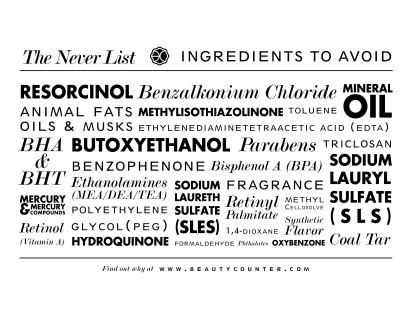Greenwashing… What is in your personal care product?
Posted: July 1, 2014 Filed under: Non Toxic Living | Tags: all natural, detox, green living, Personal care products, toxin free living Leave a commentDoes your products claim to be “all natural’? Are you trying to free your life of toxins in the places you can control? If your answer was YES to any of these questions, then you will want to read this…
I talk with people all the time about the personal care products they use. Most people will either tell me they use dermatology prescribed products or that they use very natural/green products. The interesting thing to me as an observer is that they seem very confident that they are using SAFE products because someone prescribed to them or because the product claims to be natural. But when I ask them if they KNOW what ingredients are actually is in their products they are not able to tell me, and if they are we cannot pronounce half of them. Not long ago I did a test with my mother in law. She mentioned to me that her all natural shampoo was great. So I challenged her to look at the ingredients. We were both disappointed to see many really bad ingredients listed under the ingredients list (online, because the product did not have an ingredient list on the bottle).
More often than not we blindly trust companies to be looking after our health and in a perfect world I would agree that companies should not be putting out products which can contribute to health concerns. But we live in a time and age dictated by profitability and small margins, and sometimes companies in non-regulated industries choose to use ingredients that have never been tested for safety, or that have been deemed “safe is small quantities”. If we have the right to know what is in the products we eat, the same should apply for the products we put on our skin.
Have you ever heard the term “greenwashing”?
“Greenwashing” is a term used to describe the abuse of marketing claims in products that aren’t up to par with the claims. For instance a product that says “all natural” but the disclaimer in the back in small print says it contains only 86% ingredients derived from natural sources. What is natural source anyway? We will talk about that later in this piece.
Because the FDA allows cosmetic companies to self-regulate and no new federal law has been passed in the United States in the cosmetic industry since 1938, companies are allowed to claim and print anything on personal care products, such as your shampoo, toothpaste all the way to your kids grooming products (this was the biggest shocker to me!).
With this phenomenon “companies that only care about products can use marketing as a persuasive tool to convince you that their product contains natural ingredients, when in fact, it’s loaded with petrochemicals and contains the most minimal and ineffective amount of that good ingredients you want. Companies that care about people, the planet, and profits will have their philosophy and purpose statement on their website. If you agree with their vision and if they’re honest about their product’s ingredients, more than likely you can support their business.”[1]
There are a couple of tools you, as the consumer, can use to protect yourself:
1) Use the Environmental Working Group database www.EWG.org/skindeep and check all the products you and your family currently use for their health classification/concerns. Another great resource for information on products is the Think Dirty App. You can also find new alternatives in the EWG site, you can select product type and browse the products with the best ratings.
2) There are many resources out there about ingredients to avoid, but one that I like a lot is the Beautycounter’s The Never List. The company has done the homework and rounded up this awesome list of 26 ingredients not present in their products and they also explain why in their site. Print and keep this list in your purse and most importantly USE IT. This is valuable information literaly at your fingertips. Try your best to avoid products with ingredients from this list. If the ingredients aren’t listed on your product, search for them on the company’s site. If you cannot find them, most likely there is something bad for you in it.
3) Check the company’s website: what is their mission, what type of corporation is this company (non for profit, Traditional or Benefit Corp). Search for companies that adopt transparency as one of their values.
4) Read and learn more about “Greenwashing” at http://sinsofgreenwashing.org
My favourite “sin of greenwashing” to reflect on: The “SIN OF VAGUENESS: A claim that is so poorly defined or broad that its real meaning is likely to be misunderstood by the consumer. ‘All-natural’ is an example. Arsenic, uranium, mercury, and formaldehyde are all naturally occurring, and poisonous. ‘All natural’ isn’t necessarily ‘green’.” [2]
Take charge of your life! Decide what products you will buy not by what companies are marketing to you, but because you researched the ingredients used, because there is transparency and open communication allowing YOU to truly choose what you will put on your skin! #jointhemovement #Beautycounter #Safecosmetics
[1] Source MindBodyGreen article What Non-Toxic Beauty Products *Can* We Use? July 1, 2014
[2] Source The Seven Sins of Greenwashing from the http://www.Sinsofgreenwashing.org
The Never List source – https://www.beautycounter.com/the-never-list